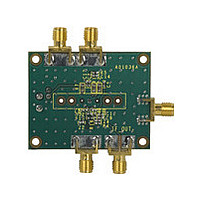AD8342-EVAL Analog Devices Inc, AD8342-EVAL Datasheet - Page 18

AD8342-EVAL
Manufacturer Part Number
AD8342-EVAL
Description
Manufacturer
Analog Devices Inc
Datasheet
1.AD8342-EVAL.pdf
(24 pages)
Specifications of AD8342-EVAL
Lead Free Status / Rohs Status
Not Compliant
AD8342
HIGH FREQUENCY APPLICATIONS
The AD8342 is a broadband mixer capable of both up and
down conversion. Unlike other mixers that rely on on-chip
reactive circuitry to optimize performance over a specific band,
the AD8342 is a versatile general-purpose device that can be
used from arbitrarily low frequencies to several GHz. In
general, the following considerations help to ensure optimum
performance:
•
•
•
•
As an example, Figure 51 shows the AD8342 as an up-
converting mixer for a W-CDMA single-carrier transmitter
design. For this application, it was desirable to achieve −65 dBc
adjacent channel power ratio (ACPR) at a −13 dBm output
power level. The ACPR is a measure of both distortion and
noise carried into an adjacent frequency channel due to the
finite intercept points and noise figure of an active device.
Because a W-CDMA channel encompasses a bandwidth of
almost 5 MHz, it is necessary to keep the Q of the matching
circuit low enough so that phase and magnitude variations are
below an acceptable level over the 5 MHz band. It is possible
to use purely reactive matching to transform a 50 Ω source
to match the raw ~1 kΩ input impedance of the AD8342.
However, the L and C component variations could present
production concerns due to the sensitivity of the match. For
this application, it is advantageous to shunt down the ~1 kΩ
170MHz
INPUT
Minimize ac loading impedance of IF port bias network.
Maximize power transfer to the desired ac load.
For maximum conversion gain and the lowest noise
performance, reactively match the input as described in the
IF Port section.
For maximum input compression point and input intercept
points, resistively terminate the input as described in the
IF Port section.
100nH
4.7pF
Figure 51. W-CDMA Tx Up-Conversion Application Circuit
VPOS
0.1µF
1nF
VPOS
0.1pF
100pF
1nF
499Ω
100pF
100pF
13
14
15
16
VPDC
VPLO
COMM
RFCM
RFIN
VPMX
PWDN
LOCM
AD8342
1nF
1970MHz
EXRB
OSC
LOIN
1.82kΩ
100pF
1nF
COMM
COMM
IFOM
IFOP
COMM
COMM
8
7
6
5
VPOS
VPOS
100pF
34nH
34nH
100pF
1nF
1nF
ETC1-1-13
2140MHz OUT
Rev. A | Page 18 of 24
input impedance using an external shunt termination resistor
to allow for a lower Q reactive matching network. The input is
terminated across the RFIN and RFCM pins using a 499 Ω
termination. The termination should be as close to the device as
possible to minimize standing wave concerns. The RFCM is
bypassed to ground using a 1 nF capacitor. A dc blocking
capacitor of 1 nF is used to isolate the dc input voltage present
on the RFIN pin from the source. A step-up impedance
transformation is realized using a series L shunt C reactive
network. The actual values used need to accommodate for the
series L and stray C parasitics of the connecting transmission
line segments. When using the customer evaluation board with
the components specified in Figure 51, the return loss over a
5 MHz band centered at 170 MHz was better than 10 dB.
External pull-up choke inductors are used to feed dc bias into
the open-collector outputs. It is desirable to select pull-up choke
inductors that present high loading reactance at the output
frequency. Coilcraft 0302CS series inductors were selected due
to their very high self-resonant frequency and Q. A 1:1 balun
was ac-coupled to the output to convert the differential output
to a single-ended signal and present the output with a 50-Ω ac
loading impedance.
The performance of the circuit is shown in Figure 52. The
average ACPR of the adjacent and alternate channels is
presented vs. output power. The circuit provides a 65 dBc ACPR
at −13 dBm output power. The optimum ACPR power level can
be shifted to the right or left by adjusting the output loading
and the loss of the input match.
–60
–62
–64
–66
–68
–70
–25
Figure 52. Single Carrier W-CDMA ACPR Performance of Tx
Up-Conversion Circuit (Test Model 1_64)
–20
OUTPUT POWER (dBm)
–15
–10
ALTERNATE
CHANNELS
ADJACENT
CHANNELS
–5
0










